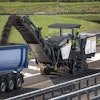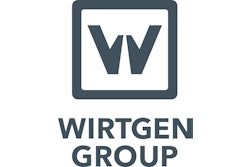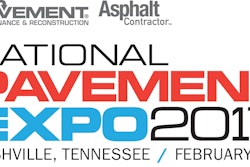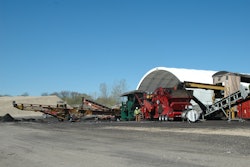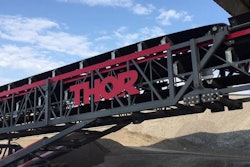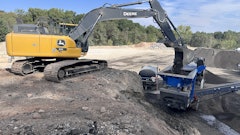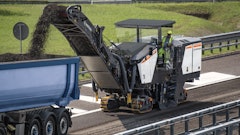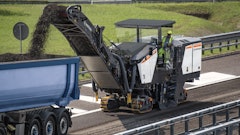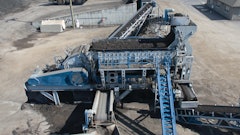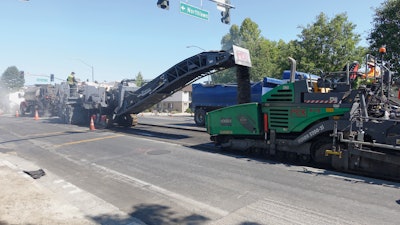
The challenge:
Resurface 100 miles of San Jose's main traffic arteries.
The players:
MCK Services Inc.
The process:
In California, a 950-hp Wirtgen 3800 CR recycler is resurfacing 100 miles of San José’s main traffic arteries in situ (on the spot), together with a Vögele VISION 5200-2i tracked paver in a rear-load process. With this method, the 3800 CR travels in reverse, removing the damaged asphalt layers in a down-cut process and transferring the recycled material to the paver.
 The milling and mixing rotor of the Wirtgen 3800 CR granulates the damaged asphalt layers to a depth of 18 cm. At the same time, cement is mixed in and water and bitumen emulsion or foamed bitumen are injected into the mixing chamber via injection bars. The final mix is transferred via the discharge conveyor directly to the material hopper of the Vögele paver which then paves true to line and level. Afterwards, Hamm asphalt rollers compact the pavement.
The milling and mixing rotor of the Wirtgen 3800 CR granulates the damaged asphalt layers to a depth of 18 cm. At the same time, cement is mixed in and water and bitumen emulsion or foamed bitumen are injected into the mixing chamber via injection bars. The final mix is transferred via the discharge conveyor directly to the material hopper of the Vögele paver which then paves true to line and level. Afterwards, Hamm asphalt rollers compact the pavement.
Down-cut method increases paving quality
 Wirtgen down-cut process: The milling and mixing rotor rotates in the direction of travel. This prevents large chunks of pavement from breaking off.
Wirtgen down-cut process: The milling and mixing rotor rotates in the direction of travel. This prevents large chunks of pavement from breaking off.
The contractor, MCK Services Inc., elected to use the process for this job to achieve a particularly high level of paving quality. In the down-cut process developed by Wirtgen, the milling drum rotates in the direction of travel, not against it as in the up-cut process. As a result, particle size can be precisely controlled when processing the material, especially on very brittle, thin, old asphalt roads.
New load-bearing capacity for the streets of San José
One illustrative example is W. Campbell Avenue, a main road in San José in the heart of Silicon Valley. The Wirtgen cold recycler, with its usual reliability, first milled off a 4-inch layer of damaged asphalt across a width of 12 feet 6 inches, granulated it and mixed in the 1% pre-spread cement.
Two tank trucks supplied the recycler with hot bitumen and water via connected hose lines. Added pressurized air generates foamed bitumen. Microprocessor-controlled injection bars ensure precision injection of the foamed bitumen – in this case 2.5% – into the mixing chamber, where it is optimally processed with the granulated material. Ejectors positioned on the rotor then transfer the mix to the 3800 CR’s conveyor belt.
Meanwhile, traffic in front of the Starbright Theater, at the corner of Fulton Street, continued to flow by the recycling train apparently undisturbed, thanks to the fact that pavement rehabilitation is completed in a single pass, without the trucks having to weave in and out of the lane. This increases safety and is a tremendous relief to the traffic system.
The Wirtgen 3800 CR machine concept is geared to maximum output so that rehabilitation projects can be completed quickly. With this in mind, the conveyor system also has an extremely high conveying capacity. The slewing and height-adjustable conveyor rapidly transfers material to the material hopper on the tracked paver, which then places a 4-inch layer and pre-compacts the surface. The HD+ 110 VVHF tandem roller and GRW 280i pneumatic tire roller from Hamm perform final compaction, giving the road a closed, smooth surface texture.
Cost-efficient and eco-friendly
After 100 miles and – thanks to in-situ cold recycling – a short construction time, Bob Garrigan, Superintendent at MCK Services, is pleased. “Thanks to the Wirtgen 3800 CR, we were able to fully comply with the traffic and budget requirements stipulated by the City of San José,” Garrigan said.
 One special challenge was that the jobsites were spread over the entire San Jose downtown are. No problem: the Wirtgen Cold Recycler 3800 CR can easily be transported by flat bed trailer.
One special challenge was that the jobsites were spread over the entire San Jose downtown are. No problem: the Wirtgen Cold Recycler 3800 CR can easily be transported by flat bed trailer.
In the end, the results speak for themselves: Some 9,600 fewer truck hours significantly reduced carbon dioxide emissions, fuel consumption and construction traffic on streets that receive between 12,000 and 35,000 vehicles daily. In total, the city saved some $1.5 million.
Frank Farshidi, Project Manager for the City of San José, also arrives at a positive conclusion. “Cold recycling in-situ fulfills exacting quality requirements, is extremely economical, environmentally-friendly, and has the least impact on the public,” Farshidi said.



